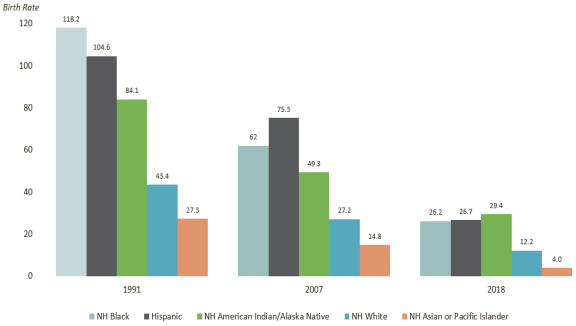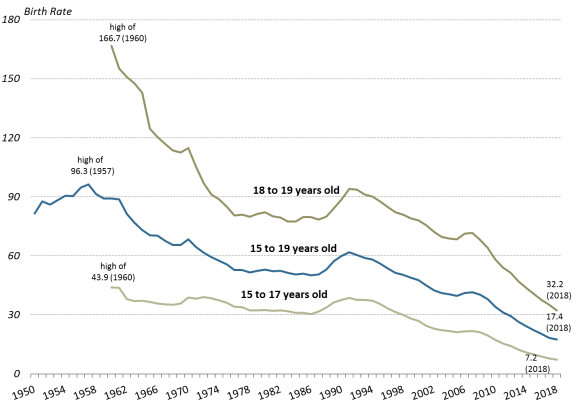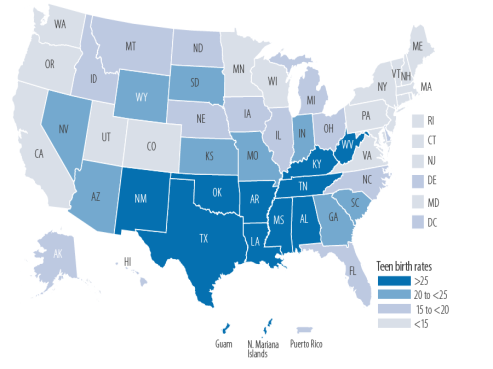Introduction
This report provides context for Congress about the U.S. teen birth rate—or the number of births per 1,000 females aged 15 to 19 each year—and its changes since the 1950s. Over this period, the teen birth rate has generally been in decline. This decline has been most significant in recent years, with the rate reaching a record low in 2018. Multiple factors have likely contributed to the decrease, though the influence of any single factor is not fully known. Reduced teen sexual activity, particularly among younger adolescents, could be one explanation. Increases in use of contraceptives, including highly effective and multiple methods, among sexually active teens could be another. Other factors, such as broader social and economic trends, may also be at play.
Despite the decline in the teen birth rate, Congress continues to be interested in the issue of teen birth because of its high social and economic costs for both individual families and society more generally.1 Further, disparities persist in teen birth rates among racial and ethnic subgroups and across states.
This report accompanies CRS Report R45183, Teen Pregnancy: Federal Prevention Programs, which discusses Congress's current approach of supporting programs that seek to prevent pregnancy among teens.
Teen Births in the United States
Data on births are distinct from data on pregnancies. The teen birth rate refers to the number of live births per 1,000 teen girls aged 15 through 19. The teen pregnancy rate includes the number of pregnancies per 1,000 teen girls aged 15 through 19, which encompasses live births, abortions, and fetal losses. Birth data account for nearly every birth in the United States, whereas pregnancy data are based on estimates of miscarriages and abortion numbers that draw on various reporting systems and surveys. The Centers for Disease Control and Prevention (CDC), the federal government's lead public health agency, reports birth data on an annual basis (most recently for 2018). The CDC and the Guttmacher Institute publish teen pregnancy rates. These rates are usually published a year or two after birth data because of the time required to incorporate data from the various data sources.2
This report focuses on the teen birth rate. The CDC tracks birth rates by age and other characteristics of birth mothers. In 2018, there were approximately 3.8 million births in the United States.3 About 180,000 of these births (4.7%) were to teenagers aged 15 to 19.4 Figure 1 shows the U.S. teen birth rate from 1950 through 2018 (the rate excludes the territories).
The rate ticked up in the baby boom era of the 1950s, peaking in 1957 at 96.3. It then decreased in most years from the 1960s through the 1980s.5 From 1991 onward, the teen birth rate declined except in two years, 2006 and 2007. The rate dropped by 72% from 1991 (61.8) to 2018 (17.4). In other words, about 6% of teens aged 15 to 19 gave birth in 1991 compared to less than 2% in 2018.
The greatest decline in the teen birth rate occurred in recent years. For example, from 2007 to 2018, the rate declined by about 58%. The 2018 teen birth rate of 17.4 was a historical low since CDC began collecting and reporting birth data in the 1940s. The CDC began tracking subgroup data for teens in 1960, when the teen birth rate was highest for both teens aged 15 to 17 (43.9 per 1,000) and teens aged 18 to 19 (166.7 per 1,000). Figure 1 indicates that the birth rate was higher in each year for the older teens compared to the younger teens. The 2018 birth rates for 15- to 17-year-olds (7.2 per 1,000) and 18- to 19-year-olds (32.3 per 1,000) were the lowest on record.
Repeat teen births have also declined over time. CDC found the number of subsequent teen births among youth aged 15 to 19 declined nationally by nearly 54% from 2004 to 2015 (the most recent analysis available). The prevalence of teen births that were repeat births was highest among Hispanic youth, followed by non-Hispanic black and non-Hispanic white youth. Over this same period, the largest declines in the number of repeat births were among black teens (21.8%), followed by Hispanic (16.8%) and white (13.9%) teens.6 Teen mothers have also been less likely to be married than in previous years. In 2018, the birth rate for unmarried teens aged 15 to 19 was 16.0 per 1,000. This is compared to 31.0 per 1,000 in 2010.7
Despite the overall decline in the teen birth rate, the rates for certain racial and ethnic groups remain relatively high. Teen birth rates in 2018 varied based on race and ethnicity, with three groups—Hispanic (26.7), non-Hispanic black (26.2), and non-Hispanic American Indian/Alaska Native (29.4) teens—having more than double the teen birth rate for non-Hispanic white (12.2) and non-Hispanic Asian or Pacific Islander (4.0) teens.8
Figure 2 shows the teen birth rate by race and Hispanic origin over three key years: 1991, when the teen birth rate started a long-term decline; 2007, the most recent year when the teen birth rate had ticked back up slightly; and 2018, the most recent year for which CDC compiled historical teen birth rate data by race and ethnicity. In nearly each year from 1991 through the recent period, the teen birth rate decreased for all racial and ethnic groups; however, the rates declined more for certain groups compared to others.9 From 2007 to 2018, birth rates fell by 55% for non-Hispanic white teens, 40% for non-Hispanic American Indian/Alaska Native teens, 58% for non-Hispanic black teens, 73% for non-Hispanic Asian/Pacific Islander teens, and 65% for Hispanic teens. While the birth rates for two groups (non-Hispanic black and Hispanic) had a greater decline than the rate for white teens, their birth rates remained higher.
|
Figure 2. Teen Birth Rates by Race and Hispanic Origin, Selected Years (1991, 2007, 2018) Birth rate is per 1,000 females aged 15 to 19 for each racial/ethnic group |
 |
|
Source: Brady E. Hamilton and T.J. Mathews, "Continued Decline in Teen Births in the United States, 2015," HHS, CDC, NCHS, NCHS Data Brief, no. 259, Data Table for Figure 2, September 2016, https://www.cdc.gov/nchs/data/databriefs/db259_table.pdf#2; and Congressional Research Service correspondence with HHS, CDC, January 2020. |
In 2018, the birth rate for teens aged 15 to 19 varied considerably by state and territory. The state with the lowest reported rate was Massachusetts (7.2); the state with the highest reported rate was Arkansas (30.4).
Figure 3 shows a map with 2018 teen births rates in four data categories for the 50 states, the District of Columbia, and three of the territories. Eighteen states had rates of less than 15 per 1,000 teens aged 15 to 19: California, Colorado, Connecticut, Maine, Maryland, Massachusetts, Minnesota, New Hampshire, New Jersey, New York, Oregon, Pennsylvania, Rhode Island, Utah, Vermont, Virginia, Washington, and Wisconsin. Ten states had the highest teen birth rates (25 or higher): Alabama, Arkansas, Kentucky, Louisiana, Mississippi, New Mexico, Oklahoma, Tennessee, Texas, and West Virginia. The rates for the territories ranged from 19.3 in Puerto Rico to 34.4 in Guam.10 From 2007 (when the birth rate last ticked up) to 2018, the teen birth rate decreased in each state or territory by between 19% and 67%.11
Teen birth rates have also declined in rural areas over time but remain relatively higher than rates in urban areas.12
While the U.S. teen birth rate has decreased over time, it has been higher than that of most other industrialized countries.13 For comparison, the U.S. teen birth rate of 18.8 was about 50% higher than the rate of the United Kingdom, 12.6, in 2017 (based on the most recent international data available).14 The reasons for the high teen birth rate in the United States relative to other industrial countries have not been fully explored. Economic conditions and income inequality within and between countries may play a role.15 Further, the research literature, which is somewhat dated and limited, indicates that use of contraceptives among teens appears to be greater in other developed countries compared to the United States.16
Factors Likely Contributing to the Declining Risk of Teen Pregnancy
Researchers suggest that multiple trends have driven down U.S. teen pregnancy and teen birth rates. They point to certain factors as the reason for declines over the 1990s through 2007. Research indicates that over this period, the risk of teen pregnancy decreased primarily because of improved contraceptive use, including an increase in the use of certain contraception methods (e.g., condoms), an increase in the use of multiple methods of contraception, and substantial declines in foregoing contraception.17 In addition, some of the risk of pregnancy decreased among younger teens, those ages 15 to 17, because of decreased sexual activity.18 A primary factor for more recent declines in the risk of teen pregnancy has also been the increasing use of contraceptives among sexually active teens. From 2007 through 2014, teens increased their contraceptive use, including the use of any method, the use of long-acting reversible contraceptives (LARCs; e.g., intrauterine devices, or IUDs, and birth control implants), and the use of the withdrawal method along with another method.19
Broad economic and social variables may influence teen behaviors, such as whether they will abstain from sex or use contraceptives.20 Behavioral changes may have been driven by a confluence of factors, such as expanded educational and labor market opportunities for women and improvements in contraceptive technology.21 Some observers theorize that the long-term downward trend in teen birth rates is attributable to the recession that began in 2007. They contend that during economic downturns the decrease in teen births—like the decrease in overall births—is partly due to teenagers being more careful as they witness the economic difficulties faced by their families.22 Despite this rationale, the teen birth rate continued to diminish after the recession (as well as during periods of economic expansion in the 1990s). Another possible explanation for the decline is the role of social media and increased use of the internet in teens' knowledge about sex and birth control. One analysis found that there were more rapid declines in rates of teen childbearing in places where the MTV show 16 and Pregnant was more widely viewed.23 The study extrapolated that teens changed their behavior (e.g., increasing the use of contraceptives) after viewing the show. Still, teen birth rates declined even after ratings for the show peaked.
Some observers contend that teen pregnancy prevention programs, such as those supported with federal funding, could potentially play a role in the declining birth rate for teenagers.24 However, the extent to which these programs have caused a decline in the teen birth rate is not fully known.25
Financial and Social Costs of Teen Births
Teen pregnancy has high costs for the families of teen parents and society more generally.26 Teenage mothers and fathers tend to have less education and are more likely to live in poverty than their peers who are not teen parents. For example,
- nearly one-third of teen girls who have dropped out of high school cite pregnancy or parenthood as a reason,
- about 7 out of 10 teen mothers who have moved out of their family's household live below the poverty level, and
- more than 60% of teen mothers receive some type of public benefits within the first year after their children are born.27
Lower levels of education reduce teen parents' potential for economic self-sufficiency. At the same time, being impoverished and having less education can also increase the likelihood of teens becoming pregnant in the first place.28 These poorer outcomes may be explained in part by underlying differences between those who give birth as teens and those who delay childbearing: teen mothers often come from more disadvantaged backgrounds (e.g., family more likely to receive public welfare benefits, parents have lower levels of education) than their counterparts who have children at a later age.29 In addition, teen sexual activity even among those who do not become pregnant can increase the risk of sexually transmitted infections (STIs), which can led to long-term health issues. Adolescents aged 15 to 19 have certain STIs at a rate that is among the highest of sexually active individuals.30
Further, teen childbearing can also affect the offspring of teen parents. Children of teenage mothers have poorer outcomes than children of mothers who give birth in their early 20s or later. They are generally more likely to (1) have chronic medical conditions, (2) use public health care, (3) have lower school readiness scores, (4) do poorly in school, (5) give birth during their teen years (females), and (6) be incarcerated (males).31 In addition to the consequences for teens and their families, teen childbearing has societal impacts.
One study examined these societal impacts, specifically estimating the cost savings to public programs that were associated with avoiding unintended pregnancies during the teen years. The Power to Decide32 did a simulation analysis to estimate the number of births to teenagers that had been averted due to the decrease in teen fertility rates from 1991 to 2015. The analysis then estimated total savings of $4.4 billion for this period, taking into consideration the cost savings to Medicaid that would have been associated with labor and delivery, postpartum care for the mother, and infant care; and receipt of Temporary Assistance for Needy Families (TANF), Supplemental Nutrition Assistance Program (SNAP), and Special Supplemental Nutrition Program for Women, Infants, and Children (WIC) benefits. Additional research of decreased or delayed teenage pregnancy and childbearing could help to inform the impacts for teen parents, their children, and society more generally.33
Appendix. Additional Data on Teen Pregnancy
|
Year |
Birth Rate |
Year |
Birth Rate |
Year |
Birth Rate |
|
1950 |
81.6 |
1973 |
59.3 |
1996 |
53.5 |
|
1951 |
87.6 |
1974 |
57.5 |
1997 |
51.3 |
|
1952 |
86.1 |
1975 |
55.6 |
1998 |
50.3 |
|
1953 |
88.2 |
1976 |
52.8 |
1999 |
48.8 |
|
1954 |
90.6 |
1977 |
52.8 |
2000 |
47.7 |
|
1955 |
90.3 |
1978 |
51.5 |
2001 |
45.0 |
|
1956 |
94.6 |
1979 |
52.3 |
2002 |
42.6 |
|
1957 |
96.3 |
1980 |
53.0 |
2003 |
41.1 |
|
1958 |
91.4 |
1981 |
52.2 |
2004 |
40.5 |
|
1959 |
89.1 |
1982 |
52.4 |
2005 |
39.7 |
|
1960 |
89.1 |
1983 |
51.4 |
2006 |
41.1 |
|
1961 |
88.6 |
1984 |
50.6 |
2007 |
41.5 |
|
1962 |
81.4 |
1985 |
51.0 |
2008 |
40.2 |
|
1963 |
76.7 |
1986 |
50.2 |
2009 |
37.9 |
|
1964 |
73.1 |
1987 |
50.6 |
2010 |
34.2 |
|
1965 |
70.5 |
1988 |
53.0 |
2011 |
31.3 |
|
1966 |
70.3 |
1989 |
57.3 |
2012 |
29.4 |
|
1967 |
67.5 |
1990 |
59.9 |
2013 |
26.5 |
|
1968 |
65.6 |
1991 |
61.8 |
2014 |
24.2 |
|
1969 |
65.5 |
1992 |
60.3 |
2015 |
22.3 |
|
1970 |
68.3 |
1993 |
59.0 |
2016 |
20.3 |
|
1971 |
64.5 |
1994 |
58.2 |
2017 |
18.8 |
|
1972 |
61.7 |
1995 |
56.0 |
2018 |
17.4 |
Source: Table prepared by the Congressional Research Service based on data from the Department of Health and Human Services, Centers for Disease Control and Prevention, National Center for Health Statistics.

